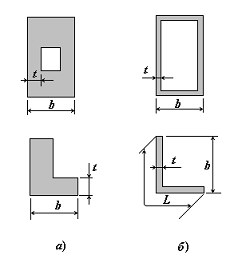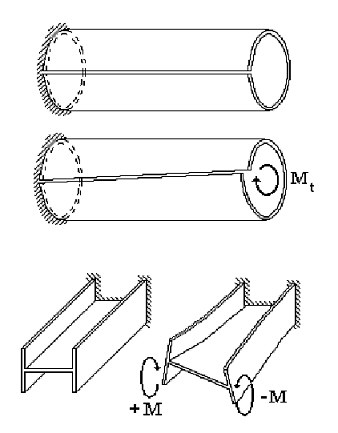
Thin-walled bars can be found in a great variety of structures used in various fields of engineering. In some cases a thin-walled bar model describes a structure as a whole (such as a multi-storey building with load-bearing walls or a span of a bridge), while in other cases this model can be used to describe important load-bearing components of a framework.
In structural mechanics, a bar refers to a body with the maximal overall cross-sectional dimension bmax much smaller than the length l.
The minimal cross-sectional dimension of a solid bar, tmin, has the same order of magnitude as bmax (Fig.1, a). For thin-walled bars, tmin << bmax so, obviously, tmin << L, where L is the length of the cross-section contour of the bar [2] (Fig.1, b). A bar is usually considered to be thin-walled if the following inequalities hold:
t / b < 0,1; b / l < 0,1.

Figure 1
A key difference in the behavior of a thin-walled bar under a load from that of a solid bar is that the plane-sections hypothesis can be violated in the case of the thin-walled bar. A typical example is a free torsion of an open-profile bar (a pipe with a longitudinal cut) or a deformation of an I-beam loaded by a bimoment at its end (Fig. 2). A deviation from the plane-sections hypothesis is a feature more immanent to open-profile thin-walled bars than to closed-profile ones.
A theory for analysis of open- and closed-profile bars of this type was developed by V.Z. Vlasov [3] and A.A.Umanski [4],[5] (see also [6]).
Tonus enables you to consider any arbitrary (including mixed open-close) profile. It uses a modification of a unified thin-walled bar theory suggested by E.A. Beilin [7]. Unlike Section Builder and Consul, this software implements a different approach to the creation of a cross-section model. The application assumes that a section is thin-walled and is being built of strips; the user specifies the thickness of each strip and the position of its centerline.

Figure 2
For the designed section Tonus determines:
The geometric properties are always calculated considering the section as continuous, neglecting the ductility of connecting grates and/or plates.
It should be noted that in case of a section with equal moments of inertia (Iy = Iz) the angle α is undefined. The axes shown on the screen are to some extent accidental, since in the considered case the ellipse of inertia degenerates into a circle of inertia (iy = iz = iu = iv), so any orthogonal couple of central axes can be considered as the principal one.
The calculation of geometric properties is not a goal by itself. It is assumed, that the calculation results will be used during the further analysis of the stress-strained state, in particular, when specifying the initial data in any program of the structural calculation. Moreover, the program can be used to calculate the stiffness properties of buildings and structures and their elements. Tonus enables to obtain the fields of normal stresses if the internal forces in the section have been specified.